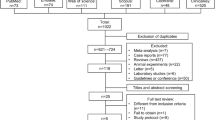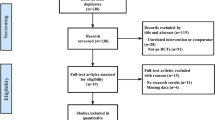Summary
BACKGROUND: The aim of this study was to compare the efficacy and side effects of gabapentin, amitriptyline, and their combination in women with chronic pelvic pain. METHODS: In this open-label, prospective, randomized trial, 56 women with chronic pelvic pain were investigated with a two-year follow-up at the Vienna Medical University Hospital. If pain intensity assessed by a visual analog scale (VAS) was 5 or more (0, no pain; 10, maximal pain), despite analgesic therapy using the nonopioid drug metamizol together with weak opioids, patients were randomized to receive gabapentin (n = 20), amitriptyline (n = 20), or a combination of both drugs (n = 16). Doses of gabapentin and amitriptyline were increased to maximum daily doses of 3600 mg and 150 mg, respectively, until sufficient pain relief or the occurrence of side effects. VAS and side effects were evaluated before treatment and at 1, 3, 6, 12 and 24 months afterwards. RESULTS: All patients experienced significant pain relief during the observation period. However, after 6, 12 and 24 months, pain relief was significantly better in patients receiving gabapentin either alone or in combination with amitriptyline than in patients receiving monotherapy with amitriptyline (gabapentin: 0 months, 7.7 ± 1.5; 6 months, 1.6 ± 0.9; 12 months, 1.5 ± 0.9; 24 months, 1.9 ± 0.9; amitriptyline: 0 months, 7.3 ± 1.5; 6 months, 2.2 ± 1.6; 12 months, 2.2 ± 1.6; 24 months; 3.4 ± 0.9; amitriptyline-gabapentin: 0 months, 7.6 ± 0.8; 6 months, 1.3 ± 0.9; 12 months, 1.7 ± 1.0; 24 months, 2.3 ± 0.9). Side effects were lower in the gabapentin group than in the two other groups, the difference reaching statistical significance after three months (P < 0.05). CONCLUSION: Gabapentin alone or in combination with amitriptyline is better than amitriptyline alone in the treatment of female chronic pelvic pain.
Zusammenfassung
EINLEITUNG: Gegenstand der Studie war der Vergleich der Wirksamkeit und Verträglichkeit von Gabapentin bzw. Amitriptylin allein mit der Kombination der beiden Medikamente bei chronischen Unterbauchschmerzen (chronic pelvic pain, CPP). METHODEN: 56 weibliche Patientinnen mit chronischen Unterbauschmerzen wurden bei der prospektiven, randomisierten Open-label-Studie mit einem 2-jährigem Follow-up an der Schmerzambulanz der Universitätsklinik Wien, Österreich, eingeschlossen. Wenn die Schmerzintensität trotz analgetischer Therapie mit dem Nichtopioid Metamizol und einem schwachen Opioid gemessen auf der visuellen Analogskala (VAS) bei 5 oder darüber lag (0, kein Schmerz; 10, schlimmster vorstellbarer Schmerz), wurden die Patientinnen randomisiert einem der drei Behandlungsarme zugeteilt (Gabapentin, n = 20; Amitriptylin, n = 20, oder beides, n = 16). Die Medikamentengaben von Gabapentin bzw. Amitriptylin wurden auf eine tägliche Dosis von 3600 mg bzw. 150 mg gesteigert, bis eine suffiziente Schmerzerleichterung erreicht war oder unerwünschte Nebenwirkungen auftraten. VAS-Werte wurde vor Beginn der Behandlung und 1, 3, 6, 12 und 24 Monate danach erhoben. ERGEBNISSE: Alle Patientinnen erfuhren während des Beobachtungszeitraumes eine signifikante Schmerzreduktion. Dennoch war die Schmerzreduktion bei Patientinnen, die Gabapentin allein oder in Kombination mit Amitriptylin erhalten hatten, signifikant höher als unter Monotherapie mit Amitriptylin (Gabapentin: 0, 7,7 ± 1,5; 6, 1,6 ± 0,9; 12, 1,5 ± 0,9; 24, 1,9 ± 0,9; Amitriptylin: 0, 7,3 ± 1,5; 6, 2,2 ± 1,6; 12, 2,2 ± 1,6; 24, 3,4 ± 0,9; Amitriptylin-Gabapentin: 0, 7,6 ± 0,8; 6, 1,3 ± 0,9; 12, 1,7 ± 1,0; 24, 2,3 ± 0,9). Unerwünschte Nebenwirkungen traten signifikant seltener in der Gabapentin-Gruppe auf als in den beiden anderen Gruppen (P < 0,05). KONKLUSION: Diese Ergebnisse legen nahe, dass die Pharmakotherapie mit dem Antikonvulsivum Gabapentin die Behandlung von chronischen Unterbauchschmerzen bei ambulanten Patientinnen verbessert.
Similar content being viewed by others
Author information
Authors and Affiliations
Corresponding author
Rights and permissions
About this article
Cite this article
Sator-Katzenschlager, S.M., Scharbert, G., Kress, H.G. et al. Chronic pelvic pain treated with gabapentin and amitriptyline: A randomized controlled pilot study . Wien Klin Wochenschr 117, 761–768 (2005). https://doi.org/10.1007/s00508-005-0464-2
Received:
Accepted:
Published:
Issue Date:
DOI: https://doi.org/10.1007/s00508-005-0464-2




